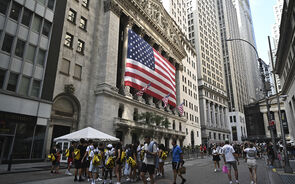Study indicates 5 1/2-year low in NYSE 'buying power' + Gold
1 Mensagem
|Página 1 de 1
Study indicates 5 1/2-year low in NYSE 'buying power' + Gold
Panic selling, now on hold, is ahead
Study indicates 5 1/2-year low in NYSE 'buying power'
By Thom Calandra, CBS.MarketWatch.com
Last Update: 10:47 AM ET Feb 5, 2003
SAN FRANCISCO (CBS.MW) - Financial markets are exhibiting serious signs of stress.
Researcher Paul F. Desmond sees increased indicators of a looming meltdown in stocks. Desmond has distinguished himself from most other U.S. strategists by his assertion that the stock market, with valuations not far from all-time highs, has yet to experience the intense selling needed to create true bargain hunting.
"The last series of 90 percent downside days followed quickly by a 90 percent upside day was at the bottom in September 1998," Lowry's Report's Desmond says about his signature indicator: days during which volume and points gained or lost equal 90 percent of the NYSE's total.
"The absence of a series of 90 percent downside days is what has helped us to identify all of the market rallies since mid-2000 as simply bear-market rallies," Desmond tells me. See: Party's over, says pioneering analyst.
Desmond says his gauges for buying power and selling pressure on the New York Stock Exchange are flashing warning signals for the overall stock market. The buying-power index, a measure of the money that flows into stocks, based on positive price changes and volume for the NYSE's 3,500 or so stocks, on Jan. 21 fell to its lowest level in 5 1/2 years.
History is what sets apart Desmond's indexes from other, proprietary technical measures of stock market activity. The buying and selling indexes go back to 1938 and technician L.M. Lowry, who used studies dating to 1933 for his calculations. See: Lowry's Reports.
"These indicators, when shown together, allow investors to see the forces of supply and demand at work," Desmond says.
The only thing that prevented a complete meltdown in the U.S. stock market - days during which 90 percent or more of all trades are tainted in red ink -- was an easing of Desmond's selling-pressure index, which gauges the flow of money out of stocks on a daily basis. The respite from panic selling produces so-called snap-back days - those 1 percent or so gains in the Standard & Poor's 500 Index that investors are starting to recognize as way-stations on the way to devastation.
"If strong, sustained buying enthusiasm did not emerge from the deeply discounted prices prevailing at the October 2002 low, then even lower prices, below the Oct low, could be necessary to eventually rejuvenate investor confidence," says Desmond, who has issued an intermediate sell signal to his clients. "The probabilities point toward a new series of 90 percent downside days during the current market decline." See: Why Dow is destined to dive.
On the gold front
As the price of gold posts six-year highs, some wonder why gold-mining stocks as a group have yet to notch new highs.
In part, Wall Street shares the blame - for repeatedly downgrading mining stocks based solely on their rising prices. Wall Street, as Bernie Schaeffer of Schaeffer's Investment Research points out, has downgraded shares of Canada's Goldcorp (GG), perhaps the most profitable gold miner in the world, at least four times since December.
The hedging challenge hits another sour note. Some of the largest producers, namely Barrick Gold (ABX) and Placer Dome (PDG), have hedged their future success by selling forward part of their production. The practice, in which producers sell tons of gold to investment banks at slightly higher prices for future delivery, allows miners to reap more profits when gold prices are falling.
When gold prices are rising, as they have been for almost two years, hedged producers put their balance sheets at risk. John C. Doody, editor of Gold Stock Analyst, estimates Barrick's hedge-book alone may be $1 billion "negative" if gold's price stays where it is or goes higher.
Doody says Barrick's earning release and conference call on Feb. 13 "should be interesting." Shareholders surely will want to know why they own a stock that is trailing the returns of its peer group, as measured by the Philadelphia Gold & Silver Index, by almost 25 percent in the past 12 months.
The antithesis of hedged producer is Goldcorp's top executive, Robert McEwen. He considers gold a form of currency. McEwen hoards as much as 10 percent of the company's production from its lucrative Red Lake Mine in Canada - a mine that produced 140,00 ounces of gold in the most recently reported quarter at a cash cost of $63 per ounce. The gold price Wednesday morning was at $382.
Doody, editor of Gold Stock Analyst and one of the very few bullion researchers with consistently profitable findings, says there's more to the gold-stock story than meets the eye. Many of the mid-tier miners, those producing half-a-million or so ounces of bullion a year, are enjoying share prices just 10 percent below their all-time highs. Goldcorp, whose American Stock Exchange-listed shares sport a $2.4 billion market worth, has seen its shares quadruple in the past 24 months.
"The intermediates, in my opinion, need the gold price to catch up with them," says Doody, who measures the worth of a gold company based on ounces it expects to pull from the ground, estimated reserves and special situations. "They now trade as though gold is over $500 an ounce. Priced for perfection, they are all vulnerable."
All except one, says Doody. "Iamgold (IAG) deserves to be in the club -- to catch up to the four amigos, Goldcorp, Glamis Gold (GLG), Agnico-Eagle Mines (AEM) and Meridian Gold (MDG).
Iamgold (IMG), which produces in western Africa's Mali and in Ghana, sports a $410 million market worth on its freshly listed AMEX shares. Its reserves of 3.35 million proven and provable ounces, divided by stock-market worth, comes to $1,500 an ounce. That's far cheaper than the $4,800-per-ounce average the stock market is placing on those four most successful mid-sized miners.
Doody sees Iamgold's shares going as high as $12.82, or more than double their $5.25 price. "Based on market-cap-per-ounce valuations, Iamgold will double from here, in my opinion," says Doody, whose forecasts over two decades of gold reporting rank among the most prescient in the mining business.
Study indicates 5 1/2-year low in NYSE 'buying power'
By Thom Calandra, CBS.MarketWatch.com
Last Update: 10:47 AM ET Feb 5, 2003
SAN FRANCISCO (CBS.MW) - Financial markets are exhibiting serious signs of stress.
Researcher Paul F. Desmond sees increased indicators of a looming meltdown in stocks. Desmond has distinguished himself from most other U.S. strategists by his assertion that the stock market, with valuations not far from all-time highs, has yet to experience the intense selling needed to create true bargain hunting.
"The last series of 90 percent downside days followed quickly by a 90 percent upside day was at the bottom in September 1998," Lowry's Report's Desmond says about his signature indicator: days during which volume and points gained or lost equal 90 percent of the NYSE's total.
"The absence of a series of 90 percent downside days is what has helped us to identify all of the market rallies since mid-2000 as simply bear-market rallies," Desmond tells me. See: Party's over, says pioneering analyst.
Desmond says his gauges for buying power and selling pressure on the New York Stock Exchange are flashing warning signals for the overall stock market. The buying-power index, a measure of the money that flows into stocks, based on positive price changes and volume for the NYSE's 3,500 or so stocks, on Jan. 21 fell to its lowest level in 5 1/2 years.
History is what sets apart Desmond's indexes from other, proprietary technical measures of stock market activity. The buying and selling indexes go back to 1938 and technician L.M. Lowry, who used studies dating to 1933 for his calculations. See: Lowry's Reports.
"These indicators, when shown together, allow investors to see the forces of supply and demand at work," Desmond says.
The only thing that prevented a complete meltdown in the U.S. stock market - days during which 90 percent or more of all trades are tainted in red ink -- was an easing of Desmond's selling-pressure index, which gauges the flow of money out of stocks on a daily basis. The respite from panic selling produces so-called snap-back days - those 1 percent or so gains in the Standard & Poor's 500 Index that investors are starting to recognize as way-stations on the way to devastation.
"If strong, sustained buying enthusiasm did not emerge from the deeply discounted prices prevailing at the October 2002 low, then even lower prices, below the Oct low, could be necessary to eventually rejuvenate investor confidence," says Desmond, who has issued an intermediate sell signal to his clients. "The probabilities point toward a new series of 90 percent downside days during the current market decline." See: Why Dow is destined to dive.
On the gold front
As the price of gold posts six-year highs, some wonder why gold-mining stocks as a group have yet to notch new highs.
In part, Wall Street shares the blame - for repeatedly downgrading mining stocks based solely on their rising prices. Wall Street, as Bernie Schaeffer of Schaeffer's Investment Research points out, has downgraded shares of Canada's Goldcorp (GG), perhaps the most profitable gold miner in the world, at least four times since December.
The hedging challenge hits another sour note. Some of the largest producers, namely Barrick Gold (ABX) and Placer Dome (PDG), have hedged their future success by selling forward part of their production. The practice, in which producers sell tons of gold to investment banks at slightly higher prices for future delivery, allows miners to reap more profits when gold prices are falling.
When gold prices are rising, as they have been for almost two years, hedged producers put their balance sheets at risk. John C. Doody, editor of Gold Stock Analyst, estimates Barrick's hedge-book alone may be $1 billion "negative" if gold's price stays where it is or goes higher.
Doody says Barrick's earning release and conference call on Feb. 13 "should be interesting." Shareholders surely will want to know why they own a stock that is trailing the returns of its peer group, as measured by the Philadelphia Gold & Silver Index, by almost 25 percent in the past 12 months.
The antithesis of hedged producer is Goldcorp's top executive, Robert McEwen. He considers gold a form of currency. McEwen hoards as much as 10 percent of the company's production from its lucrative Red Lake Mine in Canada - a mine that produced 140,00 ounces of gold in the most recently reported quarter at a cash cost of $63 per ounce. The gold price Wednesday morning was at $382.
Doody, editor of Gold Stock Analyst and one of the very few bullion researchers with consistently profitable findings, says there's more to the gold-stock story than meets the eye. Many of the mid-tier miners, those producing half-a-million or so ounces of bullion a year, are enjoying share prices just 10 percent below their all-time highs. Goldcorp, whose American Stock Exchange-listed shares sport a $2.4 billion market worth, has seen its shares quadruple in the past 24 months.
"The intermediates, in my opinion, need the gold price to catch up with them," says Doody, who measures the worth of a gold company based on ounces it expects to pull from the ground, estimated reserves and special situations. "They now trade as though gold is over $500 an ounce. Priced for perfection, they are all vulnerable."
All except one, says Doody. "Iamgold (IAG) deserves to be in the club -- to catch up to the four amigos, Goldcorp, Glamis Gold (GLG), Agnico-Eagle Mines (AEM) and Meridian Gold (MDG).
Iamgold (IMG), which produces in western Africa's Mali and in Ghana, sports a $410 million market worth on its freshly listed AMEX shares. Its reserves of 3.35 million proven and provable ounces, divided by stock-market worth, comes to $1,500 an ounce. That's far cheaper than the $4,800-per-ounce average the stock market is placing on those four most successful mid-sized miners.
Doody sees Iamgold's shares going as high as $12.82, or more than double their $5.25 price. "Based on market-cap-per-ounce valuations, Iamgold will double from here, in my opinion," says Doody, whose forecasts over two decades of gold reporting rank among the most prescient in the mining business.
1 Mensagem
|Página 1 de 1


